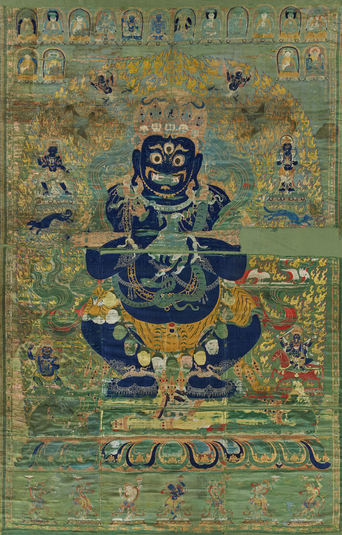
Item: Mahakala (Buddhist Protector) - Panjarnata (Lord of the Pavilion)
| Origin Location | China |
|---|---|
| Date Range | 1400 - 1499 |
| Lineages | Sakya and Buddhist |
| Material | Ground: Textile Image, Brocade |
| Collection | Private |
Panjarnata, Vajra Mahakala (Tibetan: dor je nag po chen po, gur gyi gon po. English: the Great Vajra Black One, Lord of the Pavilion), special protector of the Hevajra cycle of teachings and principal protector of the Sakya Tradition of Tibetan Buddhism. This form of Mahakala arises from the 18th chapter of the Vajrapanjara exclusive explanatory tantra. The Vajrapanjara Tantra is exclusive to the Hevajra Root Tantra whereas a tantra such as the Samputa is an explanatory tantra shared between the Hevajra and Chakrasamvara (and Yogini) root literature. The textile image above has sixteen lineage teachers depicted in a single and partial row at the top of the composition. (See Identification Key Page)
Panjaranata Main Page | Panjarnata Outline Page
Panjaranata Masterworks | Mahakala Resource Page
The unique iconographic feature of Panjaranata Mahakala as described in the Vajrapanjara Tantra and according to the special Lamdre literature of the Sakya Tradition is that he has no ghandi stick laying horizontally across the forearms. In the other more common Sakya traditions of Panjara Mahakala, such as the Three Deity, Eight Deity etc., he is generally depicted with the ghandi 'stick of emanation.' There are other exceptions to this ghandi stick rule but they are rare and not commonly found in art. The two main exceptions are for the Nagarjuna lineage form and the Ngog lineage form of Panjarnata.
As with most things related to Tantric Buddhism, there is some confusion regarding the name of this Mahakala. Specifically, the name 'panjara' or 'panjarnata' is referring to deities described in the Vajrapanjara Tantra. Therefore this form of Mahakala is the Vajrapanjara or Panjara form. However, generally speaking, there are other descriptions of this same form of Mahakala found in other tantras such as the Twenty-five Chapter and Fifty Chapter Mahakala Tantras. So, how are we to understand this?
"...the great Vajra Mahakala, blazing, with one face, two hands, in the right a curved knife and the left a skullcup filled with blood, held above and below the heart. Held across the middle of the two arms is the 'Gandhi of Emanation.' With three eyes, bared fangs, yellow hair flowing upward, a crown of five dry human skulls and a necklace of fifty wet, blood dripping, adorned with six bone ornaments and snakes, having a lower garment of tiger skin, flowing with pendants and streamers of various silks, in a posture dwarfish and thick, standing above a corpse. To the right is a black crow, left a black dog, behind a wolf, in front a black man, above a garuda, emanations of messengers issue forth, with Akshobhya as a crown, standing in the middle of a blazing fire of pristine awareness." (Konchog Lhundrub, 1497-1557).
"...a great vajra palace, vast and extensive. Inside ... a multi-coloured lotus with eight petals. ... the King of the Wrathful, Shri Vajrapani Bhutadamara, with a body blue-black in colour, one face, four hands. The first right hand holds aloft a blue vajra with tines open and the left in a wrathful gesture and holding a vajra lasso. The two main hands perform the daemon subduing mudra at the heart. The mouth has bared fangs and tongue curled, three round red eyes glaring fiercely, orange mustache, eyebrows and hair blazing upward. Having a crown of five dry skulls and a necklace of fifty wet. Adorned with eight great nagas and wearing a lower garment of tiger skin and upper robe of blue silk. Standing with the right leg bent and left straight - pressing on Bhuta Aparajita lying face down; white, with three eyes, four hands. The right holds a drum and curved knife, left a skullcup and trident, wearing a tiger skin as a lower garment and yellow hair in a top knot - standing in the middle of a fiercely blazing fire of pristine awareness." (Ngorchen Konchog Lhundrub (1497-1557). sGrub Thabs Kun bTus, vol.6, folios 6-8).
Now it comes down to appearance. If the Mahakala form has one face and two hands, squat, holding a curved knife and skullcup at the heart, and generally (but not always) holding a ghandi stick across the forearms, then it is said colloquially and in Tibetan literature that this is Panjaranata Mahakala, or the panjara form of Mahakala despite the original source text. It is likely that this came about because the Vajrapanjara Tantra and the Hevajra Tantra were so well known as early Tantric literary works and practice traditions. Because the panjara name was so well known and represented the one face, two armed, form of Mahakala, it is therefore most likely that the name panjara came to be applied to all forms of Mahakala that had this same appearance.
Alternate Names: Vajra Panjara, Vajra Panjarnata, Panjara, Panjarnata, Panjara Mahakala, Panjarnata Mahakala, Panjarnatha.
Rinchen Zangpo Lineage of Teachers: Vajradhara, Vajrapanjara Dakini, Brahmin Vararuchi, Pandita Deva Vajra, Shraddha Karavarma, Lochen Rinchen Zangpo, Drag Tengpa Yontan Tsultrim, Mal Lotsawa Lodro Drag, Sachen Kunga Nyingpo (1092-1158), Sonam Tsemo, Dragpa Gyaltsen, Sakya Pandita, Chogyal Pagpa, Anyen Mopa, Dagnyi Chenpo Dharmapala Rakshita, Zangpo Pal, Gandenpa Kunga Sonam, Gonpo Rinchen Gyaltsen, Tegchen Choje Kunga Tashi, etc.
Jeff Watt 9-2014
Subject: Video - Three Treasures at Sotheby's, New York (March, 2024)
Textile: Woven Artwork Main Page
Mahakala: Panjarnata, Lord of the Pavilion (Early Paintings)
Collection: Christie's, Chinese (March, 2006; NY)
Collection: Sotheby's New York (Painting, March 2024)
Textile: Main Page
Mahakala: Panjarnata Masterworks (Painting & Textile)
Subject: Yongle Textile Workshop Discussion (Chinese Translation)
Subject: Yongle Brocade Textiles
Subject: Yongle Textile Workshop Discussion









